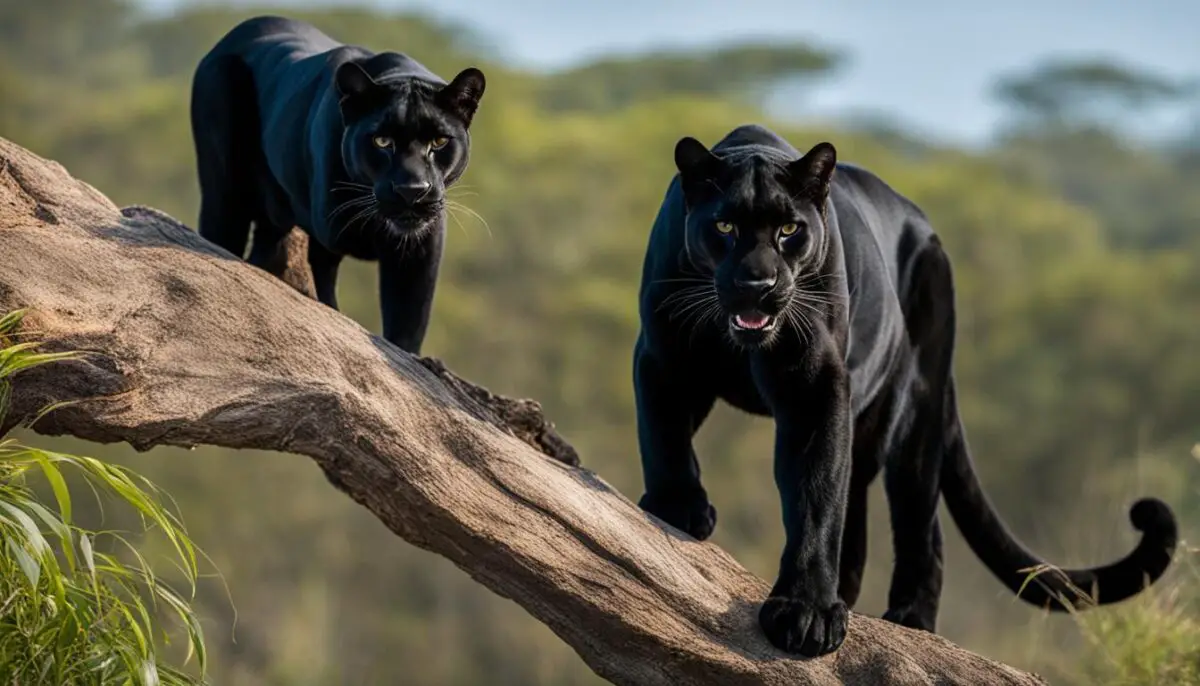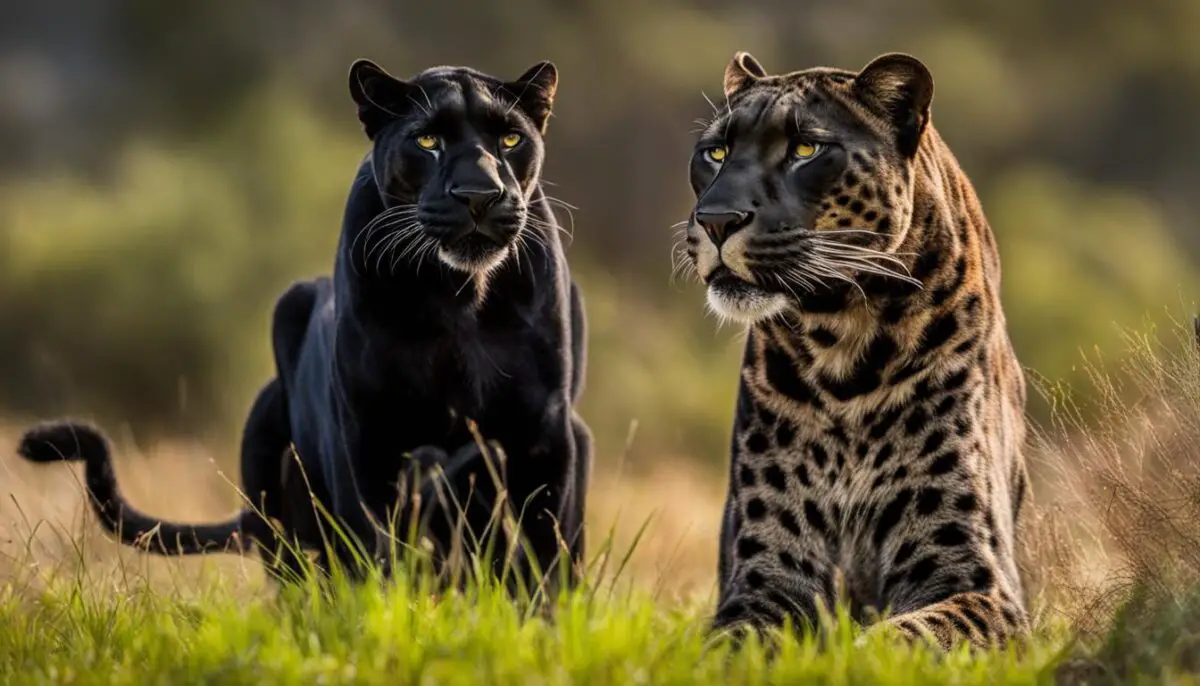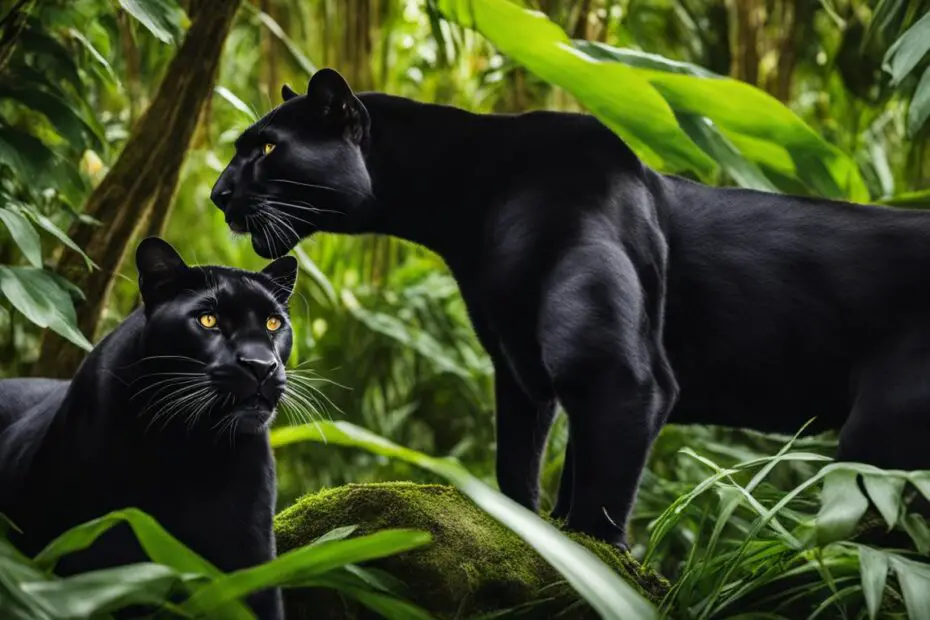When it comes to big cats, the terms “black panther” and “black leopard” are often used interchangeably, leading to some confusion. However, there are distinct differences between these magnificent creatures. Let’s dive into the characteristics, physical appearance, habitat, and behavior of black panthers and black leopards to spot the difference.
Key Takeaways:
- Black panthers and black leopards are not separate species but variations of the same species.
- Black panthers have a dark, melanistic coat that makes their spots harder to see.
- Black panthers are usually larger and have a stockier build compared to black leopards.
- While black panthers are adaptable and can be found in various habitats, black leopards primarily inhabit sub-Saharan Africa and southern Asia.
- Black panthers have a more relaxed attitude, while black leopards can be more aggressive.
Physical Differences
When it comes to their physical appearance, black panthers and black leopards exhibit distinct characteristics that set them apart. Let’s take a closer look at the differences:

| Physical Traits | Black Panthers | Black Leopards |
|---|---|---|
| Body Size | Larger and more stocky | Slender and longer |
| Body Length | Shorter | Longer |
| Leg Length | Shorter | Longer |
| Chest Width | Broader | Narrower |
| Abdomen Shape | Barrel-like | N/A |
Both black panthers and black leopards bear spots on their coats, although the size and pattern of these spots can differ. Black panthers tend to have larger spots with smaller spots inside them, creating a unique pattern on their dark fur. In contrast, black leopards have smaller spots that are grouped closer together, resulting in a distinct appearance.
Habitat
Black panthers and black leopards have distinct habitats that contribute to their survival and adaptability. Let’s explore their respective environments:
Black Panthers
Black panthers can be found in a diverse range of habitats across the world. These adaptable creatures thrive in:
- Tropical forests: With their dark coats, black panthers camouflage effortlessly in the dense foliage of tropical forests.
- Marshlands and swamplands: The wet and marshy regions offer black panthers an abundant source of prey.
- Grasslands: Black panthers skillfully blend into the tall grasses, allowing them to stalk their prey without detection.
- Deserts: Despite their dark coloration, black panthers have developed strategies to survive in desert regions.
- Mountains: These majestic big cats have been known to inhabit the elevated regions of mountains.
Their ability to adapt to such a wide array of habitats demonstrates their incredible resilience and resourcefulness.
Black Leopards
While black panthers have a global presence, black leopards primarily inhabit specific regions. Some of the habitats where black leopards can be found include:
- Rainforests: The dense vegetation and abundant prey in rainforests provide an ideal habitat for black leopards.
- Tree-lined savannah: These open grasslands with scattered trees offer black leopards cover for hunting and resting.
- Deserts: Black leopards possess the adaptability to survive in arid desert conditions.
- Mountains: Black leopards have been found in mountains, adapting to the challenges of high-altitude regions.
These varied habitats reflect the resilience and versatility of black leopards in different ecosystems.

5. Defensive Behavior
Black panthers and black leopards have well-developed defensive behaviors to protect themselves and their territories. They mark their territories with scent markings and utilize vocalizations to communicate with other individuals in their species. When threatened, black leopards can exhibit aggressive behavior, defending their domain fiercely. Black panthers, on the other hand, tend to have a more relaxed and self-confident attitude, but they can still display defensive behaviors when necessary.
| Black Panthers | Black Leopards | |
|---|---|---|
| Group Behavior | Solitary hunters | Solitary hunters |
| Activity Time | Nocturnal | Nocturnal |
| Agility and Speed | High | High |
| Climbing Abilities | Adequate | Excellent |
| Defensive Behavior | Relaxed and self-confident | Aggressive when threatened |
Overall, the behavior of black panthers and black leopards reflects their adaptability to their respective environments. Both species have evolved unique traits and hunting strategies that enable them to thrive as skilled and formidable predators.
Unique Traits
Black panthers and black leopards possess distinct qualities that set them apart.
Black Panthers:
Black panthers are known for their unique physical appearance. Their fur is glossy and dark, and they have striking emerald green eyes. These majestic creatures have a powerful build, with strong muscles that enable them to be skilled hunters. Their intelligence and agility make them formidable predators.
Black Leopards:
| Unique Traits |
|---|
| Dense fur with distinguishable black spots |
| Excellent climbers |
| Adaptability to various habitats |
Black leopards have dense fur adorned with distinguishable black spots. They possess exceptional climbing abilities, allowing them to navigate trees with ease. Moreover, these adaptable creatures have successfully adjusted to diverse habitats.
Both black panthers and black leopards are endangered species due to the threats of habitat loss and hunting. It is crucial to raise awareness and protect these remarkable animals for generations to come.
Conclusion
In conclusion, the distinction between black panthers and black leopards lies in their physical appearance, habitat, and behavior. While black panthers are larger and stockier with a shorter body, black leopards are more slender and longer. Black panthers can adapt to a variety of habitats, while black leopards primarily inhabit sub-Saharan Africa and southern Asia. Additionally, black panthers have a more relaxed attitude, while black leopards can exhibit more aggression.
Both black panthers and black leopards are captivating members of the felidae family, with their unique traits and characteristics. As magnificent creatures facing threats in the wild, it is crucial to prioritize their protection and conservation. By safeguarding their habitats and raising awareness about their significance, we can contribute to the preservation of these remarkable animals.
Let us appreciate the beauty and resilience of black panthers and black leopards, cherishing the diversity they bring to our planet’s ecosystem. Together, we can ensure a future where these extraordinary felids continue to thrive.
FAQ
What is the difference between a black panther and a black leopard?
The term “black panther” refers to the melanistic color variant of the leopard (Panthera pardus) and the jaguar (Panthera onca). It is not a distinct species but rather a term used to describe any big cat with a black coat.
Do black panthers and black leopards have spots?
Yes, both black panthers and black leopards have spots. However, the size and pattern of the spots can vary. Black panther spots are usually larger with spots inside them, while black leopard spots are smaller and grouped closer together.
Where can black panthers and black leopards be found?
Black panthers can be found in Asia, Africa, and the Americas. They are adaptable and can thrive in various habitats, including tropical forests, marshlands, swamplands, grasslands, deserts, and mountains. Black leopards primarily inhabit sub-Saharan Africa and southern Asia. They can be found in a range of habitats, including rainforests, tree-lined savannah, deserts, and mountains.
What are the physical differences between black panthers and black leopards?
Black panthers are larger and more stocky than black leopards. They have a shorter body, shorter legs, and a broader chest. Panthers also tend to have a barrel-like abdomen. In contrast, black leopards are more delicately built with a slender and longer body, longer legs, and a generally lithe appearance.
What is the behavior of black panthers and black leopards?
Black panthers are known for their confident and relaxed attitude. They are generally more self-assured and calm. Black leopards, on the other hand, can be more aggressive and are always on the lookout for predators larger than themselves. Both black panthers and black leopards are solitary hunters and primarily nocturnal creatures.
What are some unique traits of black panthers and black leopards?
Black panthers have a shiny dark fur and striking emerald green eyes. They are known for their powerful build and strong muscles. They are also intelligent and agile, making them skilled hunters. Black leopards, on the other hand, have dense fur with distinguishable black spots. They are excellent climbers and have adapted to various habitats.
Why are black panthers and black leopards endangered?
Both black panthers and black leopards are endangered species due to habitat loss and hunting.
